PEDRO de BRITO NOGUEIRA, Petrobras; KIRSTY MORTON, FIKRI KUCHUK, and RICHARD BOOTH, Schlumberger
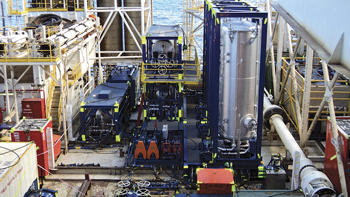 |
| The dimensions of offshore rigs demand well test equipment to be compact, modular, and streamlined as much as possible without jeopardizing test results. |
|
In 2005, while drilling an exploration well about 120 km offshore in the Campos basin, Fig. 1, Petrobras discovered an oil-bearing carbonate reservoir above a salt section and beneath the clastic turbidites that provide most of the production in the area. A sequence of three pressure-transient well tests (DSTs) over three adjacent layers were performed in the first appraisal well, followed up two years later by a four-month extended well test (EWT) to help understand reservoir behavior and geology. Test results were sufficiently favorable to move forward, and a series of development wells were drilled. However, conventional analysis raised some concerns about the quantitative use of well-test data for reservoir modeling and characterization.
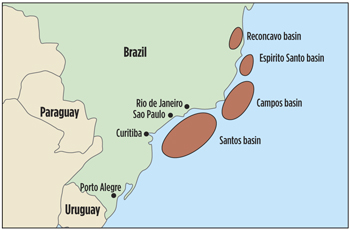 |
| Fig. 1. The Campos basin lies offshore Brazil's south-central coast. |
|
Seismic data suggested that some regions of the formation were heavily faulted due to basement horsts and surrounding salt domes. Furthermore, interpretation of openhole image logs from exploratory wells indicated that the formation contained a number of open, most likely conductive, fractures. The pressure-transient data from the well tests provided important complementary information about the reservoir in the drainage area of the well.
Traditionally, reservoir engineers interpret the pressure-transient response in formations with naturally fractured networks using dual-porosity models. In this case, although the reservoir appeared to be fractured, based on the static data, pressure-transient data did not exhibit classic dual-porosity behavior, based on initial analysis of dynamic data from the DSTs and EWT. Instead, test results could have been interpreted as the behavior of a homogeneous system with flow barriers at some distance from the wellbore.
It was vital, therefore, to understand the signature of the pressure-transient data, to determine the nature and properties of the fractures, and ideally to incorporate well-test results into the existing reservoir model—either to calibrate and validate it, or to update it. Ensuring the numerical simulation model was consistent with all the data, including dynamic test data, would also enable more reliable production predictions, especially for potential water flooding and future enhanced oil recovery (EOR) scenarios.
DISCRETELY FRACTURED RESERVOIRS
To understand the unusual behavior of this fractured reservoir, Petrobras and researchers from the Schlumberger Brazil Research and Geoengineering Center in Rio de Janeiro have started collaborating to develop an interpretation methodology for pressure-transient tests in discretely fractured reservoirs. Schlumberger reservoir engineers have observed this type of fractured reservoir behavior in many carbonate formations around the world as a potential indication of a slightly, or “discretely”, fractured reservoir, in which the fractures provide conduits for fluid flow, but are poorly connected, and are not the primary means of production.
Traditional dual-porosity models assume the formation is heavily fractured and the fractures are well connected. In these cases, the matrix acts as a distributed source, but production flows into the wellbore only by way of the fractures. In more moderately fractured reservoirs, where both matrix and fractures flow directly into the wellbore, dual-permeability models are also appropriate.
However, few if any methods exist to interpret the pressure-transient response of discretely fractured reservoirs. In these situations, matrix permeability is the primary conduit for production, although discrete fractures that intersect the wellbore may enhance the well productivity. What’s more, discrete fractures conduct fluids from remote parts of the reservoir toward the wellbore, enhancing overall permeability in the direction of the fractures and potentially altering the drainage area shape. Unless a reservoir is unfractured or poorly fractured, a single-porosity model would not sufficiently match the well-test data, nor would it honor the geological model. Therefore, new techniques are necessary to properly interpret well test data from discretely fractured reservoirs, and to use those results to constrain the reservoir model.
Schlumberger and Petrobras had recently developed two new interpretation methodologies designed specifically for pressure-transient tests in discretely fractured reservoirs. The first is a grid-based inversion technique to estimate reservoir parameters that match the pressure-transient response, using the same grid as the numerical simulation model. It allows operators to identify a variety of features—including fractures—from the background geostatistical distribution of reservoir properties. The second technique is a mesh-free, semi-analytical boundary element solution that simulates the pressure-transient response for complex fractured reservoirs without the difficulties inherent in conventional explicit fracture gridding.
This partnership between Petrobras and Schlumberger offered a great opportunity to apply these technologies in the field with a complete set of static and dynamic data to define the most likely fracture scenario. Both methodologies are now part of a suite of new Schlumberger GeoTesting pressure transient testing, design, and interpretation workflows for fractured reservoir characterization.
INTEGRATED INTERPRETATION WORKFLOW
To apply the two new techniques to the reservoir in the Campos basin, a seven-step integrated modeling and inversion workflow was developed, performed mostly within the Petrel geological modeling framework. In steps four and seven, the new algorithms were implemented as proprietary plug-ins to the commercial software.
One unique feature of the integrated workflow is that the interpretation began with the preliminary geological model, in this case, Petrobras’ model, and used dynamic pressure-transient data—not just static data such as image logs, or a single pressure point and rate measurement—both in the creation of the numerical simulation model, and in final model QC and validation. As such, all available reservoir data were honored. Although DSTs were performed in three adjacent layers of the first appraisal well, the following case study describes the seven-step process of the integrated interpretation of the first DST only:
1. Conventional well-test analysis. The first step in the workflow was conventional well-test analysis, which began with QA/QC and data cleaning. Conventional analytical models were used to interpret pressure-transient test data to provide an indication of the possible geological flow model and initial estimates of near-well reservoir parameters, Fig. 2.
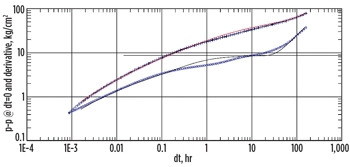 |
| Fig. 2. Log-log diagnostic plot of deconvolved data, with match to infinite conductivity fracture model in a closed reservoir area. |
|
The well had been stimulated with an acid treatment prior to cleaning up. Since initial analysis of the three build-up flow periods did not indicate any dual-porosity behavior, a finite-conductivity hydraulic fracture model was used to estimate conductivity and fracture half-length of the natural fractures intersecting the well bore.
To match the observed pressure response, high fracture conductivities would be required. However, no quantitative estimates of the actual conductivity of discrete fractures, or their distribution within the reservoir, were possible. A deconvolution algorithm applied to the pressure-rate data required a bounded reservoir model to achieve a potential match.
After filtering the pressure data, 12 separate flow periods were identified that corresponded with observable pressure transients. All flow periods were exported to the geomodeling software.
2. Sector model extraction. As preparation for numerical simulation, the second step in the workflow was to extract a sector model for the well area and reservoir layer of interest from the full-field geological model. The layer was regridded for the pressure-transient response with high-resolution gridding near the well, where pressure-transient data are more informative, with a gradual transition to coarse gridding near the sector boundaries.
After benchmarking the gridding with respect to a homogeneous analytical solution, matrix porosity and permeability from the full-field model were sampled onto the well-test grid using a surface model interpolation procedure to avoid blocky results.
3. Fracture model data preparation. The third step was to determine natural fracture data primarily from well logs to control the population of reservoir properties in the model, Fig. 3. First, tangible fracture attributes, including dip and dip azimuth, were picked from the borehole image logs. By analyzing these logs in conjunction with the sonic response, fractures were classified into eight distinct types, and further grouped into two main sets: open, conductive fractures not bounded by bedding, and partially closed fractures bounded by bedding.
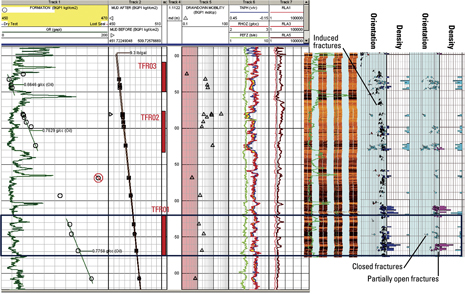 |
| Fig. 3. Initial appraisal well evaluation from openhole measurements. |
|
Fracture density, average fracture orientation and fracture apertures were estimated for each fracture set. Within the tested interval, fractures were predominantly open, thus conductive, with a high dip angle and NE strike direction.
Next, a fracture intensity log was created for the two main fracture sets, and upscaled onto the well-test grid. Fracture density is the most important parameter for fracture modeling in either discretely or continuously fractured reservoirs. Traditionally, fracture properties derived from borehole geology are distributed across the static reservoir model using geostatistical or stochastic methods, and training images or trends derived from seismic or geomechanical data. However, all of these methods rely on static measurements that have not been calibrated with fluid flow paths derived from dynamic pressure-transient test data. Next, the first of the two new interpretation techniques was applied to map flow within the reservoir based on the pressure-transient test response.
4. Grid-based parameter estimation. In step four, the new grid-based inversion algorithm, based on an efficient adjoint gradient method, was used to estimate the most likely parameters that matched the pressure-transient test response. In this case, effective permeability was the primary parameter of interest. The term “effective permeability” refers to the expected combination of both fracture and matrix permeability, and its value in a discretely fractured reservoir will be higher than the matrix permeability in grid cells that contain open fractures.
Parameter estimation is considered complete when an acceptable match with the observed pressure data is obtained. Matrix permeability sampled onto the sector model in step two was used as a first approximation of effective permeability prior to assimilation of the well-test data. As expected, the initial pressure-response simulation and history match with the real data was poor. In 134 subsequent optimization steps, however, the inversion algorithm converged on the maximum likelihood solution for effective permeability, achieving a good match.
For DST 1, the effective permeability around the well had to be increased, Fig. 4, to obtain a match with measured pressure-transient test data. This suggested that grid cells within the well-test radius of investigation contained a high density of conductive fractures.
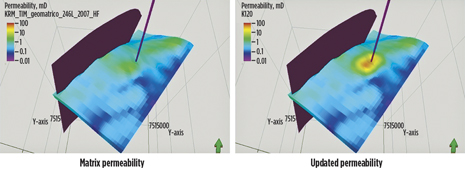 |
| Fig. 4. Effective permeability before and after grid-based parameter estimation. |
|
5. Fracture-density calibration. Step five was to positively correlate the fracture density derived in step three with the effective permeability derived in step four. Fracture intensity from the image log picks was upscaled onto the well-test simulation grid, and the upscaled log was kriged onto the full 3D grid using the most likely effective permeability from the well test as a secondary variable for co-kriging. Intensity distribution was further enhanced by data analysis of the image log. The output was a fracture density property calibrated with both static wellbore properties and the dynamic pressure response derived from the well-test inversion.
6. Discretely fractured reservoir modeling. The sixth step was to combine the well-test calibrated fracture density with the direction and orientation statistics derived from image log dip picks, and to create a stochastic fracture model for the near-well sector model. Due to reservoir structure, Petrobras geologists and geomechanics engineers determined that only fractures in the NE strike direction should be considered fully open. This conclusion was consistent with the image log analysis. Thus only these fractures were included in the modeling process.
Fracture modeling based on a density property can be performed either implicitly or explicitly, depending on fracture length. In discretely fractured reservoirs, the assumption is that fractures should primarily be modeled explicitly. Output from this step was a set of stochastically generated fracture planes.
7. Discrete fracture verification. The final step of the integrated workflow applied the second of the two new techniques for pressure-transient test interpretation, as a dynamic verification of the discrete-fracture modeling process. In addition to standard QC of the output fracture distribution to the input fracture parameters, it was essential to verify that any individual realization of discrete fractures created in step six continued to provide an acceptable match with the observed pressure data.
The new mesh-free, semi-analytical discrete fracture algorithm allows the pressure response in a well to be generated either for arbitrarily placed infinite or finite conductivity natural fractures. Fractures can be connected to each other or the wellbore. The match obtained by applying the new method was excellent, and no iteration of fracture properties was required.
Petrobras considered the updated fracture density map a geologically plausible scenario that fit the observed data. The final sector model, Fig. 5, honored all available data, including the petrophysical data for matrix permeability, the image-log and seismic data for fracture orientation and aperture, and the well-test pressure data for effective permeability and fracture density.
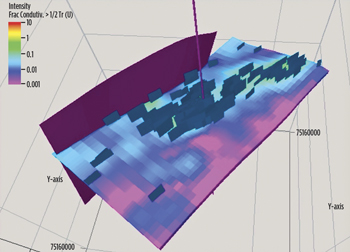 |
| Fig. 5. Well-test-derived fracture intensity property and the resulting stochastically generated fractured planes. |
|
Fracture apertures and associated conductivities are often the least known parameters. Yet, sensitivity studies indicate that fracture conductivities may be the most sensitive parameter for discretely fractured reservoir models. Therefore, had a mismatch been observed during this final step, it would have been necessary to perform a small uncertainty loop to update the fracture conductivity until a match was obtained within prior geologically defined limits. If that additional step still failed to achieve a match, the correlation applied in step five would have been reconsidered.
CONCLUSIONS
Using the new integrated interpretation workflow, pressure-transient well-test data validated the conceptual fractured reservoir model and provided geologically meaningful parameters in the near-well area. As a result, Petrobras will be able to incorporate the generated fracture properties into the full-field model.
In this case study, the integrated workflow was applied on a single well. However, single-well test cases lack full directional information. Thus, it would be more effective to apply this process to multiple-well interference tests. In addition, although the workflow was initially developed for discretely fractured carbonate reservoirs, it could be applied to any type of complex fractured reservoir. By integrating dynamic with static data, the methodology enables operators to leverage the full range of data in which they have invested millions of dollars, rather than limiting their analyses either to static data alone or to a single pressure point and rate measurement.
The two new interpretation techniques introduced here can allow geoscientists and reservoir engineers to perform pressure-transient analysis in reservoirs with continuous and discrete fracture systems. Of course, the methodology is very general and can be applied to any type of reservoir. Pressure-transient analysis must have strong support from geosciences to provide meaningful and consistent reservoir parameters. Misunderstanding of the pressure-transient data could lead to under optimized development strategies. For complex fractured reservoirs, especially in costly offshore and deepwater environments, more advanced techniques are necessary to reconcile static and dynamic data, and provide a direct means of calibrating the fractured reservoir model with pressure-transient test and rate measurements. 
ACKNOWLEDGEMENT
The authors thank Petrobras and Schlumberger management for permission to publish this work. This article is based on a paper presented at the EAGE Annual Conference & Exhibition, incorporating SPE Europec, held in Copenhagen, Denmark, June 4–7, 2012.
|
The author
PEDRO de BRITO NOGUEIRA is a manager of reservoir evaluation for Petrobras in the Operational Unit of Rio de Janeiro. He has 10 years of experience with Petrobras, where he has always worked with formation evaluation. Nogueira earned an MS degree in Petroleum Engineering from Unicamp, São Paulo, Brasil.
KIRSTY MORTON is a senior reservoir engineer for Schlumberger Testing Services based in Clamart, France. Morton joined Schlumberger in 2004 after receiving a PhD from the Institute of Petroleum Engineering, Heriot-Watt University. Morton also has a BSc (Hons) in Physics from Edinburgh University. She has previously worked in Schlumberger Data and Consulting Services in Aberdeen, UK, and as the reservoir program manager at the Schlumberger Brazil Research and Geoengineering Center in Rio de Janeiro.
FIKRI KUCHUK, Schlumberger Fellow, is currently chief reservoir engineer for Schlumberger Testing Services. He was a consulting professor at the Petroleum Engineering Department of Stanford University from 1988 to 1994 and taught Advanced Well Testing. Before joining Schlumberger in 1982, he worked on reservoir performance and management for BP/Sohio Petroleum Company. He has an MS degree from the Technical University of Istanbul, and MS and PhD degrees from Stanford University, California.
RICHARD BOOTH is a senior research scientist in the reservoir engineering group of Schlumberger Brazil Research and Geoengineering Center in Rio de Janeiro. He joined Schlumberger in 2008 after completing a doctorate from at the Oxford University of Oxford in Mathematics applied to a problem from Reservoir Engineering. He also holds a MMath degree from Oxford. |
|








